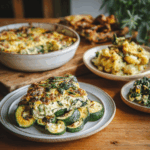Follow Me On Social Media!
Ricotta Salata Cheese: A Tangy, Savory Gem You Need in Your Kitchen
Ricotta salata cheese is the secret ingredient I never knew I needed—until a summer trip to Sicily changed everything. One bite of a ripe tomato salad sprinkled with this firm, aged cheese, and I was hooked. In this post, we’re diving into the world of ricotta salata cheese—what it is, how to use it, and why it deserves a spot in your kitchen. Whether you’re tossing it into a salad or shaving it over pasta, this underrated dairy delight brings a salty punch that transforms ordinary dishes into something memorable.
The Story & Intro — Why I Fell in Love with Ricotta Salata
From Grandma’s Ricotta to a Sicilian Surprise
I’ve worked in kitchens across the South and taught community classes, but my roots? They start in my grandmother’s Savannah kitchen. I knew ricotta well—soft, spreadable, comforting. But I didn’t meet ricotta salata cheese until my 40s, during a visit to a farmer’s market in Palermo. A vendor handed me a sliver of this white, crumbly cheese and called it “ricotta’s grown-up cousin.” He wasn’t wrong.
Unlike the creamy version I used in lasagna back home, ricotta salata is pressed, salted, and aged. It’s firmer, tangier, and built for grating or slicing. It quickly became my favorite trick for adding richness to light dishes—especially in warmer months.
Now, I toss it into everything from summer grain bowls to roasted vegetables. It brings that salty bite that lifts the whole plate—no fuss, just flavor. It’s even fantastic over this creamy parmesan Italian sausage soup or crumbled over a crisp chicken salad for a salty punch.
What Makes Ricotta Salata Cheese Stand Out?
Let’s be clear: ricotta salata isn’t just aged ricotta. It’s a transformation. Through pressing and salting, the texture becomes sliceable, and the flavor deepens into something briny and savory, almost like feta—but cleaner and less sour.
The cheese is typically made from sheep’s milk in Italy, though you’ll find cow’s milk versions here in the U.S. It’s aged for about 90 days, making it firm enough to crumble, grate, or shave. That versatility? It’s why I keep a block in my fridge at all times. It’s especially delicious shaved over warm roasted vegetables, stirred into couscous, or added to pasta for a salty finish.
I use it often in place of parmesan in lighter dishes like zucchini pasta or as a topping for garlic parmesan chicken pasta. It’s that finishing touch you didn’t know your meal needed.

Understanding Ricotta Salata – What It Is and Why It Matters
What Exactly Is Ricotta Salata Cheese?
Ricotta salata cheese is often misunderstood because of its name. It’s not the soft, creamy ricotta you find layered in lasagna or spooned into stuffed shells. Instead, ricotta salata cheese is pressed, salted, and aged, creating a firm, crumbly texture that makes it ideal for grating, slicing, or crumbling over everything from salads to pastas.
Made traditionally from sheep’s milk, this cheese has a mildly nutty, slightly salty flavor that intensifies with aging. The aging process removes most of the moisture, turning a delicate cheese into one with bite and structure. If you’ve never cooked with ricotta salata cheese before, you’re in for a pleasant surprise—it’s versatile, easy to use, and incredibly flavorful.
It’s also lactose-friendly compared to many fresh cheeses, making it a better choice for those with mild sensitivities. Because it holds its shape when heated, it can be used where other cheeses might melt too quickly. That’s why I often use it in place of parmesan or feta, especially in dishes like this chicken parmesan recipe where a crumble of ricotta salata cheese on top adds extra depth.
The Italian Roots of Ricotta Salata Cheese
Ricotta salata cheese hails from Sicily, where it’s been a pantry staple for generations. The word “salata” means salted in Italian—a clear hint that this cheese has been purposefully preserved. While fresh ricotta is typically consumed within days, ricotta salata cheese is made to last longer and travel farther.
In classic Sicilian cuisine, it’s often shaved over pasta alla Norma—a dish with eggplant and tomato sauce. It’s also found in Mediterranean-style salads and even with roasted vegetables, much like how I serve it alongside blackened chicken and grilled zucchini.

Cooking with Ricotta Salata Cheese – Simple, Flavorful Ways to Use It
How to Cook with Ricotta Salata Cheese Without Overcomplicating It
The beauty of ricotta salata cheese is how effortless it is to use. You don’t need a fancy recipe or a long list of ingredients—this cheese does most of the heavy lifting for you. Because it’s firm and salty, it works best as a finishing element. Think of it as the final touch that wakes up a dish.
Shave it with a vegetable peeler over warm pasta or roasted squash. Crumble it over a lentil salad or a bowl of herbed couscous. One of my favorite tricks? Tossing it into easy soup recipes just before serving. It melts slightly but keeps its texture, adding a creamy-salty contrast.
For summer, slice it thin and layer it into a tomato and cucumber salad with a drizzle of olive oil. It’s also perfect on toast with smashed peas or even sprinkled on top of garlic fries for a Mediterranean twist.
Best Flavor Pairings for Ricotta Salata Cheese
Because ricotta salata cheese is subtly briny, it pairs beautifully with sweet, acidic, or earthy ingredients. Tomatoes, olives, roasted peppers, lemon zest, and fresh herbs like basil and mint all shine beside it. For proteins, pair it with grilled fish, herb-roasted chicken, or even as a garnish for a grain bowl topped with cheesecake cookies for an unconventional sweet-savory snack.
I especially love it alongside sautéed greens like kale or spinach, or shaved over grilled eggplant with a splash of red wine vinegar. Its flavor stands up well to both mild and bold components.
Whether you’re keeping it simple or experimenting with layers of flavor, ricotta salata cheese is the kind of ingredient that works hard behind the scenes—quietly making every bite better.
Substitutes, Pairings & FAQs – What to Know About Ricotta Salata Cheese
Great Substitutes for Ricotta Salata Cheese
If you can’t find ricotta salata cheese at your local market, don’t worry. There are some excellent stand-ins that offer a similar salty kick and crumbly texture. Feta is the most common substitute, though it’s a bit tangier and wetter. Goat cheese can also work in a pinch, though it’s creamier and best when you want that soft, melt-in-your-mouth contrast.
For a firmer option, try aged manchego or pecorino romano. They offer that aged, savory note without overwhelming the dish. I often tell my readers that if they’re already making something with Mediterranean flavors—like a pasta dish or a protein-packed salad—you can substitute with confidence. In fact, I used shaved pecorino in place of ricotta salata once in a tomato grain bowl paired with this chicken salad and it was just as satisfying.
Best Dishes to Pair with Ricotta Salata Cheese
This cheese is your friend when you want to elevate a dish without overpowering it. Use it to finish roasted vegetables, hearty stews, or even pasta. One of my go-to combinations is ricotta salata with roasted red pepper soup or as a topping for a savory grain bowl.
It also complements bright, fresh dishes—like grilled summer squash or Mediterranean-inspired sides. Add it to couscous with lemon and herbs or crumble it into a wrap with roasted chicken and arugula.
Looking to impress guests? Serve slices of ricotta salata cheese with marinated olives, crusty bread, and a drizzle of olive oil as part of an appetizer board. It’s simple, but it always disappears fast.
Frequently Asked Question
What is the difference between ricotta cheese and ricotta salata?
Fresh ricotta is creamy, soft, and moist—perfect for baking or mixing into pasta fillings. Ricotta salata cheese, on the other hand, is salted, pressed, and aged for about 90 days. It becomes firm, crumbly, and ideal for slicing or grating.
What is a substitute for ricotta salata cheese?
Feta, aged manchego, and pecorino romano are the best substitutes. Feta is most similar in texture and saltiness, while manchego and pecorino offer a firmer texture and a stronger bite. Use what fits your dish best.
How do you eat ricotta salata?
Eat it crumbled on salads, shaved over pasta, or sliced as part of a cheese board. It’s especially delicious in warm grain bowls, on blackened chicken, or tossed into roasted vegetable medleys.
Does ricotta salata taste like feta?
Somewhat. Both are salty and crumbly, but ricotta salata cheese has a milder, less tangy flavor. It’s slightly nutty and not as briny, which makes it more versatile in delicate dishes.
Conclusion
Ricotta salata cheese may not be the star of every dish, but it quietly brings depth, texture, and complexity to any meal it touches. Whether you’re tossing it into salads, layering it over soup, or using it to top a pasta, this firm, salty cheese earns its place in the kitchen. As a Southern chef with a soft spot for Mediterranean flavors, I find myself reaching for ricotta salata cheese more than ever—especially when I want something that feels a little special but still effortless.
Don’t be afraid to try it in your next meal—maybe over some garlic fries or stirred into creamy Italian soup. Trust me, once you taste that salty crumble, you’ll be hooked—just like I was.





